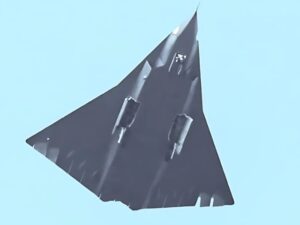China has revealed two previously unseen tailless stealth combat aircraft designs within 24 hours, marking a significant step in its next-generation fighter program.
Both aircraft are currently undergoing flight testing, and imagery of these advanced jets has surfaced on social media, drawing significant attention.
The designs are believed to come from two rival Chinese aircraft manufacturers: Chengdu Aircraft Corporation (CAC) and Shenyang Aircraft Corporation (SAC).
The first aircraft, a larger diamond-shaped tailless jet, appeared in public on December 26, 2024, coinciding with the 13th anniversary of the Chengdu J-20’s first public appearance and the birthday of Mao Zedong.
Hours later, a smaller tailless design, attributed to Shenyang, was seen in photos and videos. Both jets feature a lack of traditional tail surfaces, a design choice that enhances their stealth capabilities by reducing their radar cross-section.

Photo: @Fighterman_FFRC on X
The larger aircraft from Chengdu is believed to have a three-engine powerplant, while the Shenyang design features a twin-engine setup, indicating a smaller size.
The Chengdu jet also has a modified diamond-delta wing shape, with extended “chines” at the wing roots, while the Shenyang design features a more angular, lambda wing shape with triangular extensions at the trailing edges.

Photo: @Kanthan2030 on X
Though the exact roles of the new jets are unclear, initial reports suggest that the Chengdu design could be part of the JH-XX program, a next-generation tactical fighter-bomber intended for regional operations. This aircraft may focus on speed and stealth, providing a versatile platform for air-to-air and air-to-ground missions.
The Shenyang jet is likely a fighter, possibly designed for air superiority, though it remains unclear whether it will be crewed or operated as a drone or optionally-crewed platform.
Both designs lack vertical and horizontal tail surfaces, following a trend in China’s aerospace industry to develop tailless aircraft.
Tailless designs offer advantages in terms of reduced radar signatures, improved aerodynamic performance, and greater internal space for fuel and weapons. These features are especially important for enhancing the aircraft’s range and combat persistence in the Asia-Pacific region.







